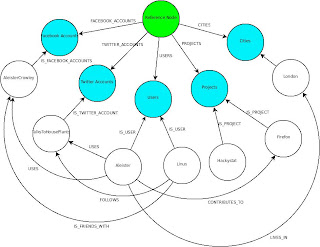Whew. Well. Where to start?
The Last Week
The biggest issues that I ran into where a result of the solution that I applied to the XML problem from last week. Because I had my own version of the Telemetry XML objects, which were identical to the Hackystat Telemetry objects but in a different package, getting things from the TelemetryClient into a form that I could send to my database was a real trial. It produced a lot of angst and some decidedly unattractive code. However, my decidedly nasty code could be ditched permanently if the Hackystat schemas were given namespaces and prefixes. That would be awesome!
The other problem that I had relating to the TelemetryClient was really strange. getChart (the one that doesn't take extra parameters) didn't work. So, I had to dig up the default parameters for all of the charts that I needed and use the getChart method that did take extra parameters. Thanks to Shaoxuan for all his help debugging that problem!
I've saved all the default parameters for the charts I'm using as String constants, so they can be accessed easily.
Another note: it was significantly non-obvious to me that the Telemetry service runs on a different port on the server, and that one would need to specify this. I'm sure it's in the documentation somewhere, but where is it?
Finally, I realized at some point yesterday that I hadn't covered a couple of the cases for the Hackystat client, such as computer crashes and so on, so I had to add those in. In other nasty surprises, as I suspected, the lack of Findbugs and PMD errors was too good to be true. So I'm not quite ready to be pulled into the Hackystat server umbrella.
What I didn't accomplish this week, that I had really hoped to accomplish, was the visualization tool. It's still next on the roster, but it doesn't get to be under the GSoC hat, I suppose.
This project became so much more gargantuan than I had intended! Looking back on the time line that I wrote at the beginning of this whole thing makes me laugh. Knowing what I know now, I might have come up with something considerably less insane!
It ended up being sort of a trial by fire! I certainly didn't expect to be standing at the end of the summer, having put together my own server! (The sensorbase was a good template to work off of, definitely!) The whole thing just ended up being so much larger and more complicated than I anticipated.
That, maybe more than anything, is what I have learned from this experience. Actual use by real people in the real world complicates even simple tasks. Really, until this summer I've been working on mostly toy projects. Nothing huge, and nothing really meant to be used by people. When making something that is supposed to be used, there are so many more things that one has to consider that I am accustomed to considering; the end result, then, is that even simple things (like pulling data from one server and sending it to another server) can spiral endlessly into complication.
Stopping that complication from overwhelming the project (and the coder!) is a really important thing, I think. It's somewhat difficult when one is sort of programming in an echo chamber of one's own mind. Because the GSoCers were all working on individual projects, it was somewhat more difficult for us to bounce ideas off one another. I feel that the current release of my project would be of significantly higher quality if I had spent more time communicating my ideas and having the designs vetted as I went. I say this because I was describing a bug to an unrelated third party, and he was like, "WTF were you thinking, designing that this way?" Coming from a place of such inexperience with real software development, it's hard to know if you're making a good design decision. How do you choose the right way when you don't know the wrong way? So I know now to take better advantage of my available resources. Perhaps--gasp, the horror!--request a code review? Spend more time talking design with my mentor? All of these things!
Beyond the new understanding of how much time things actually take, and how important collaboration is to the end product, I also learned a metric boatload of new skills and tools. JAXB, for instance, is still, to my mind, the coolest thing since the internet. Java Property files are also really awesome. Not to mention suddenly understanding how the internet really works. I mean, sure, I've done some very low level networking stuff. I've implemented go-back-n, etc. But one day after getting the SocNet server up and running I abruptly realized that when you call for a web page, it's a GET request! Some server somewhere returns a representation of the HTML to you! That was a very exciting moment for me.
I would also like to start work on the sensor discussed over the list, which crawls a repository to determine how familiar a coder is with a particular concept. It was suggested as a Master's thesis--perhaps I can make it mine?






